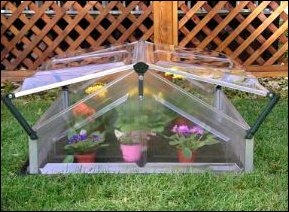 Cold frame greenhouses differ from traditional greenhouses that are constructed with heating systems. A cold frame greenhouse is an enclosure with a transparent roof that’s built very close to the ground. The top of the greenhouse is transparent to let in sunlight and keep heat from escaping through the convection process that generally occurs at night.
Cold frame greenhouses differ from traditional greenhouses that are constructed with heating systems. A cold frame greenhouse is an enclosure with a transparent roof that’s built very close to the ground. The top of the greenhouse is transparent to let in sunlight and keep heat from escaping through the convection process that generally occurs at night.
Cold frame greenhouses are used to extend the season of a traditional greenhouse, and to protect plants from inclement and cold weather.
Cold frame structures are often built as extensions of heated greenhouses (they are placed along the foundation). They are built on the southern side of the greenhouse as a transition venue for seeds that are planted and germinated in the heated greenhouse. The seeds can be moved to the cold frame to allow for an adjustment period before final planting outdoors.
Cold frame greenhouses are similar to hotboxes or hotbeds. The difference is in the amount of heat that each type of structure generates. This is the same reason greenhouses are sometimes referred to as hothouses, due to the heating system or solar energy trapped inside to heat them up.
The primary use of cold frame greenhouses is for growing plants and flowers, and on farms for growing vegetables and fruits. A separate climate is created in the structure which allows enough insulation to keep seedlings and young plants warm and protect them from the elements. These structures are a good option for framing and gardening in colder climates since seeds can be started earlier in the season, effective extending the growing season into the fall and winter months.
A variety of commercial greenhouses are available to be built on an existing site. Kits are available, and some people build their own cold frames from existing materials they already have on hand for home or farm use, sometimes using old windows for the glass with a wooden frame. Some cold frames are built so that they’re slanted in the direction of the sun during the winter months in order to obtain more sunlight facilitate water runoff. Clear plastic can be used in place of glass, and heat for the structure in the form of a heating cable can be put into the soil to give plants additional heat.
One of the main reasons to use a cold frame greenhouse is that a wide array of crops can be started in the greenhouse, then transferred to the cold frame and raised there until they’re mature. A big advantage of using a cold frame is that vegetables and fruits may be started ahead of the regular growing season when prices are extremely high.
Some of the easiest vegetables to grow in cold frame greenhouses are onions, spinach, radishes, turnips, and lettuce. One large cold frame can be used to grow a wide variety of different crops so that you’ll have fresh vegetables all year round, even when they aren’t in season.
About the author: Whitney Segura is an expert greenhouse gardener from Lafayette, Louisiana. He is also an owner of one of the largest distributors of small greenhouses and greenhouse accessories in the United States, including a full line of cold frame greenhouses, grow rack greenhouses, hobby greenhouses, lean-to greenhouses, glass greenhouses, and much more.